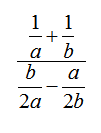A complex fraction is a fraction whose numerator or denominator contains one or more fractions. To express a complex fraction as a simple faction use one of the following methods:
Method 1: Simply the numerator and the denominator. Express the fraction as a quotient using the division symbol ÷ . Multiply by the reciprocal of the divisor.
Method 2: Find the LCD of ALL the simple fractions in the complex fraction. Multiply the numerator and the denominator of the complex fraction by the LCD
Using Method 1
Method 1: Simply the numerator and the denominator. Express the fraction as a quotient using the division symbol ÷ . Multiply by the reciprocal of the divisor.
Simplify above to get
Using Method 2
Method 2: Find the LCD of ALL the simple fractions in the complex fraction. Multiply the numerator and the denominator of the complex fraction by the LCD

Same problem as above but this time Find the LCD of all the simple fractions in the complex fraction... The LCD would be 2ab. Multiply each simple fraction by 2ab
Which simplifies to
Then you can factor:
Hopefully you realize you have been able to obtain the same simplified fraction using EITHER method. Use whichever method works BEST for you!






